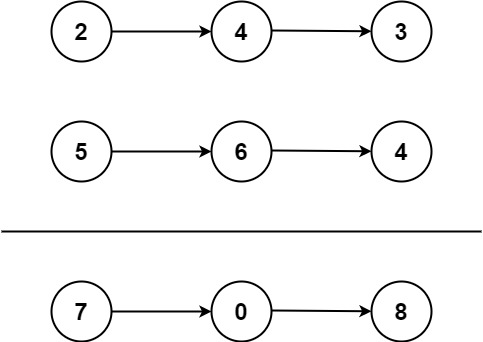You are given two non-empty linked lists representing two non-negative integers. The digits are stored in reverse order, and each of their nodes contains a single digit. Add the two numbers and return the sum as a linked list.
You may assume the two numbers do not contain any leading zero, except the number 0 itself.
Example 1:
Input: list1 =[2, 4, 3], list2 =[5, 6, 4]Output:[7, 0, 8]Explanation: 342 + 465 = 807

Example 2:
Input: list1 =[9,9,9,9,9,9,9], list2 =[9,9,9,9]Output:[8,9,9,9,0,0,0,1]Explanation: 9999999 + 9999 = 10009998
The core challenge of this problem is to add two numbers represented by linked lists where each node contains a single digit. The digits are stored in reverse order, meaning the 1's digit is at the head of the list. This problem is significant in scenarios where numbers are too large to be handled by standard data types and need to be processed digit by digit.
Potential pitfalls include handling the carry-over during addition and ensuring the linked list is correctly formed without leading zeros (except for the number 0 itself).
To solve this problem, we can use a straightforward approach by iterating through both linked lists simultaneously, adding corresponding digits along with any carry from the previous addition. If one list is shorter, we continue with the longer list. The carry is managed throughout the process.
Here is a step-by-step approach:
Here is a detailed breakdown of the algorithm:
class ListNode:
def __init__(self, val=0, next=None):
self.val = val
self.next = next
def addTwoNumbers(l1, l2):
# Initialize dummy node and current pointer
dummy = ListNode()
current = dummy
carry = 0
# Loop through both linked lists
while l1 or l2 or carry:
# Get the values of the current nodes (0 if None)
val1 = l1.val if l1 else 0
val2 = l2.val if l2 else 0
# Calculate the sum and update the carry
total = val1 + val2 + carry
carry = total // 10
total = total % 10
# Create a new node with the sum and attach to the result list
current.next = ListNode(total)
current = current.next
# Move to the next nodes in the input lists
if l1:
l1 = l1.next
if l2:
l2 = l2.next
# Return the next node of the dummy node as the head of the result list
return dummy.next
The time complexity of this approach is O(max(n, m)), where n and m are the lengths of the two linked lists. This is because we traverse both lists once. The space complexity is O(max(n, m)) as well, due to the space required for the result linked list.
Potential edge cases include:
Each of these cases is handled by the algorithm as it checks for None nodes and manages the carry appropriately.
To test the solution comprehensively, consider the following test cases:
Using a testing framework like unittest or pytest can help automate and validate these test cases.
When approaching such problems, consider breaking down the problem into smaller parts and handling each part step-by-step. Practice similar problems to improve your problem-solving skills and understand different ways to approach linked list problems.
In this blog post, we discussed how to add two numbers represented by linked lists. We covered the problem definition, approach, algorithm, code implementation, complexity analysis, edge cases, and testing. Understanding and solving such problems is crucial for improving your algorithmic thinking and coding skills.
For further reading and practice, consider the following resources:
Our interactive tutorials and AI-assisted learning will help you master problem-solving skills and teach you the algorithms to know for coding interviews.
Start Coding for FREE